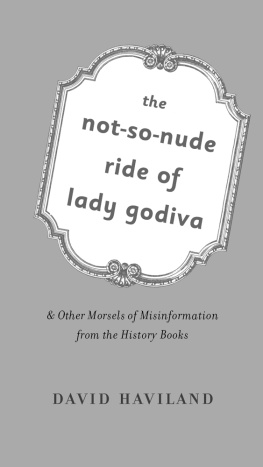the
not-so-nude
ride of
lady godiva
the
not-so-nude
ride of
lady godiva
& Other Morsels of Misinformation from the History Books
DAVID HAVILAND
JEREMY P. TARCHER
a member of Penguin Group (USA) Inc.
New York
JEREMY P. TARCHER/PENGUIN
Published by the Penguin Group
Penguin Group (USA) Inc., 375 Hudson Street, New York, New York 10014, USA Penguin Group (Canada), 90 Eglinton Avenue East, Suite 700, Toronto, Ontario M4P 2Y3, Canada (a division of Pearson Penguin Canada Inc.) Penguin Books Ltd, 80 Strand, London WC2R 0RL, England Penguin Ireland, 25 St Stephens Green, Dublin 2, Ireland (a division of Penguin Books Ltd) Penguin Group (Australia), 250 Camberwell Road, Camberwell, Victoria 3124, Australia (a division of Pearson Australia Group Pty Ltd) Penguin Books India Pvt Ltd, 11 Community Centre, Panchsheel Park, New Delhi110 017, India Penguin Group (NZ), 67 Apollo Drive, Rosedale, North Shore 0632, New Zealand (a division of Pearson New Zealand Ltd) Penguin Books (South Africa) (Pty) Ltd, 24 Sturdee Avenue, Rosebank, Johannesburg 2196, South Africa
Penguin Books Ltd, Registered Offices: 80 Strand, London WC2R 0RL, England
Copyright 2012 by David Haviland
Illustrations Ben Carder
All rights reserved. No part of this book may be reproduced, scanned, or distributed in any printed or electronic form without permission. Please do not participate in or encourage piracy of copyrighted materials in violation of the authors rights. Purchase only authorized editions.
Published simultaneously in Canada
Most Tarcher/Penguin books are available at special quantity discounts for bulk purchase for sales promotions, premiums, fund-raising, and educational needs. Special books or book excerpts also can be created to fit specific needs. For details, write Penguin Group (USA) Inc. Special Markets, 375 Hudson Street, New York, NY 10014.
Library of Congress Cataloging-in-Publication Data
Haviland, David.
The not-so-nude ride of Lady Godiva & other morsels of misinformation
from the history books / David Haviland.
p. cm.
ISBN: 978-1-101-58562-7
1. HistoryAnecdotes. 2. HistoryMiscellanea. 3. HistoryErrors, inventions, etc. I. Title.
D10.H38 2012 2012001357
909dc23
Printed in the United States of America
1 3 5 7 9 10 8 6 4 2
BOOK DESIGN BY NICOLE LAROCHE
While the author has made every effort to provide accurate telephone numbers and Internet addresses at the time of publication, neither the publisher nor the author assumes any responsibility for errors, or for changes that occur after publication. Further, the publisher does not have any control over and does not assume any responsibility for author or third-party websites or their content.
ALWAYS LEARNING
PEARSON
for beth
Chapter One
bygone
blunders

History teaches us that men and nations behave wisely once they have exhausted all other alternatives.
Abba Eban (19152002)
what was the most disastrous kidnapping in history?
The answer to this question is surely the kidnapping of Spartas Queen Helen by the Trojan prince Paris, which led to the disastrous Trojan War. Until very recently, the stories of Troy in Greek literature had been thought to be purely mythical, until archaeological evidence appeared in the late twentieth century that seemed to confirm that Troy had indeed existed, and had been a major strategic city of the time that had undergone a number of lengthy conflicts some time around the twelfth or thirteenth century B.C. Based on this evidence, it seems likely that the stories told in the classical Greek literature, particularly Homers Odyssey and The Iliad, were based to some extent on genuine historical events, although these seem to have been combined with existing myths and legends.
According to these sources, the Trojan War was sparked when Paris, Prince of Troy, kidnapped the beautiful Helen. Helen was the wife of Menelaus, the king of Sparta, and she was celebrated as the most beautiful woman in the world, famously described by Goethe many centuries later as the face that launched a thousand ships. The abduction of Helen led to a ten-year military campaign, in which the Greek forces led by Agamemnon took control of Troys allies and neighbors and laid siege to the walled city of Troy itself. However, Troy seemed to be impenetrable.
In the tenth year, Troy at last fell, thanks to a brilliant scheme devised by Odysseus, which has come to be known as the Trojan Horse. The plan went as follows. First, the Greek forces burned down their own camp and departed, leaving behind an enormous horse made of wood. Attached to this horse was a note, which explained that the horse was a ceremonial gift to the Trojans, in recognition of their victory. Clearly, it seemed, the Greeks had admitted defeat, and sailed home. The Trojans opened the gates of the city, dragged the enormous trophy inside, and began a night of boozy celebrations.
Later that same night, once all the Trojans were drunk or asleep, a group of thirty Greek soldiers emerged from inside the wooden horse. They then opened the gates of the city, to let in the rest of the Greek army, which had sailed silently back to Troy under cover of night. The Greek army now attacked, razing the city to the ground, massacring the male population, and emphatically ending the war.
why didnt the vikings settle in north america?
For centuries it was thought that the first European discovery of the Americas took place in 1492, with the arrival of Christopher Columbus, but the continent had in fact been discovered almost five hundred years earlier, by the all-conquering Vikings, some time around the year 1000. The Vikings were the worlds leading sea power at this time, and they were hungry for land in which to continue their expansion. They had already colonized Iceland in the late ninth century, and then Greenland in around 980. Iceland is around 1,000 miles (1,600 km) west of Norway, and then Greenland is a farther 700 miles (1,127 km) west of Iceland. Newfoundland in Canada is only another 600 miles (965 km) from Greenland, and its even possible that cloud formations coming off the mountains of Baffin Island may have been visible from the coastal mountains of Greenland. Its therefore no surprise that the Vikings soon became aware of the new land to the west, and it wasnt long before they had begun to explore it.
Greenland had been settled by the dangerous Viking outlaw Erik the Red, who had been banished from Iceland for committing a number of murders, as a result of a bizarre dispute over the ownership of some ornamented wooden beams (beams that, in all probability, Erik had simply stolen from the murder victims). The red of Eriks name may have been a reference to the color of his hair, or more likely his blood-soaked reputation. The exiled Erik thus settled in Greenland, and when he returned temporarily to Iceland, he came telling stories of a lush, fertile land, which he disingenuously named Greenland, in order to lure settlers to join him in the new colony. In fact, of course, there is nothing green about Greenland, which is almost entirely covered with ice the whole year round. Erik explained the deception, People would be more eager to go there if the land had a good name. His plan succeeded, and Erik was soon in charge of two settlements in Greenland.
Leif Eriksson was one of Erik the Reds sons, and some time around the year 1002 or 1003 he set out from Greenland on a voyage west, in the hope of discovering new lands. He made a number of landings, the first of which he named Helluland, which means land of flat rocks; this may have been Baffin Island. He next reached a place he called Markland, meaning woodland, which may have been Labrador. He then made landfall at a place he called Vinland, in reference to the abundant grapes he found growing there. Eriksson established a settlement on Vinland, and in the spring he traveled back to Greenland with a cargo of timber. Over the next few years, the colony began to grow, despite occasional battles with the native, pre-Inuit population.
Next page











